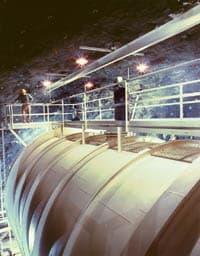After secularists invented the neutrino it took them 70 years to finally solve the problems with their new invention.
Neutrinos were discovered in 1956, they were not created, now take your Abilify
1956 – First discovery of the neutrino by an experiment
In this experiment, for which they were awarded a Nobel Prize in Physics in 1995, Clyde L. Cowan and Frederick Reines used a nuclear reactor, expecting to produce neutrino fluxes on the order of 1012 to 1013 neutrinos per second per cm2, far higher than any attainable flux from other radioactive sources. The neutrinos would then interact with protons in a tank of water, creating neutrons and positrons. Each positron would create a pair of gamma rays when it annihilated with an electron. The gamma rays were detected by placing a scintillator material in a tank of water. The scintillator material gives off flashes of light in response to the gamma rays and the light flashes are detected by photomultiplier tubes.
SOLAR NEUTRINO PROJECT
However, this experiment wasn’t conclusive enough, so they came up with a second layer of certainty. They would detect the neutrons by placing cadmium chloride into the tank. Cadmium is a highly effective neutron absorber (and so finds use in nuclear control rods) and gives off a gamma ray when it absorbs a neutron. The arrangement was such that the gamma ray from the cadmium would be detected 5 microseconds after the gamma ray from the positron, if it were truly produced by a neutrino.
They performed the experiment preliminarily at Hanford, but later moved the experiment to the Savannah River Plant near Augusta, Georgia where they had better shielding against cosmic rays. This shielded location was 11m from the reactor and 12m underground. They used two tanks with a total of about 200 liters of water with about 40 kg of dissolved CdCl2. The water tanks were sandwiched between three scintillator layers which contained 110 five-inch (127 mm) photomultiplier tubes.
After months of data collection, they had accumulated data on about three neutrinos per hour in their detector. To be absolutely sure that they were seeing neutrino events from the detection scheme described above, they shut down the reactor to show that there was a difference in the number of detected events. They had predicted a cross-section for the reaction to be about 6×10-44 cm2 and their measured cross-section was 6.3×10-44 cm2. Their results were published in 1956.
Posted in
Neutrino History
